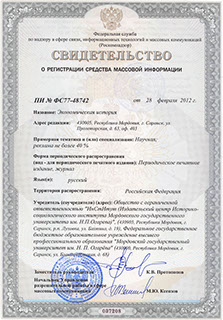Экономическая историЯ
Russian Journal of Economic History
ISSN 2409-630X (Print)
ISSN 2618-916X (Online)
Expert board:
- Scientific Council of RAS on economic history;
- Research and Educational Center «The economic history of Central Russia and the Middle Volga region» of Ogarev Mordovia State University;
- Center of Economic History of Lomonosov Moscow State University
Navigation
Certificate of registration

ISSN 2409-630X (Print), ISSN 2618-916X (Online)
DOI: 10.15507/2409-630X.044.015.201901.060-071
УДК332.2.021:93/94(470.345-25)
Sergey V. Kistanov,
National Research Ogarev Mordovia State University (Saransk, Russia)
e-mail: kistanov-viz@yandex.ru
AGRARIAN MOVEMENT IN SARANSK COUNTY IN OCTOBER-NOVEMBER 1917
Introduction. The study of the agrarian movement on the eve of the establishment of Soviet power in the regions of Russia is important in the light of determining the role of the peasantry in the process of coming into power of the Bolsheviks. It quite clearly demonstrates the polarization of social forces in the Russian village on the eve of the decisive events of the great Russian revolution in 1917, Therefore, the growth of the agrarian movement in the country during the period under review evidence of the crisis caused by the absence of a decision by the authorities of the agrarian question that occupies a prominent place in Russian social and political consciousness of the early twentieth century. Materials and Methods. The study uses the materials of the Central state archive of the Republic of Mordovia, as well as scientific literature. The main method of research used in the work is historical-genetic. A micro-historical approach is also used for a more detailed insight into the subject of the study. Results. The article deals with the direction of agricultural movement in the Saransk district through the prism of confrontation between the rich and poor parts of the village. It notes the main purpose of the agrarian-peasant movement: the landlords, the kulaks, the farmers. Forms of the agrarian movement directed against “the high society” of village are considered, and also the property damage caused to owners is stated. The study notes that the peasantry dissatisfied with the protracted solution of the agricultural issue by the Provisional government has moved to radical methods of “black redistribution”. The wealthy part of the village in these conditions was without protection from the district authorities which by the autumn in 1917 did not have any power or authority among the local population, which predetermined the success of peasant actions against “the high society”. Discussion and Conclusion. As a result of the conducted research the circle of victims in the period of “peasant revolt” in autumn 1917 in the territory of Saransk district of Penza province is revealed. Forms of influence in relation to each category of rural owners are defined. Also it notes the hopelessness of the situation of “the high society” of village against the background of the crisis of local authorities on the eve of the establishment of Soviet power..
Keywords: peasants, the landlords, the kulaks, the farmers, the Provisional government, the County Commissioner, the defeat of the estates, the felling of forests.
For citation: Kistanov S. V. Agrarian Movement in Saransk District in October-November 1917. Ekonomicheskaya istoriya = Russian Journal of Economic History. 2019; 15(1): 60–71. (In Russ.). DOI: 10.15507/2409-630X.044.015.201901.060-071
© Ogarev Mordovia State University. History and Sociology Institute, 2017
68, Of. 411, Bolshevistskaya St., 430005, The editorial office of the scholarly journal «Russian Journal of Economic History»
Tel.: (8342) 24-25-90; 27-07-11, Fax: (8342) 24-25-90, E-mail: jurnal-econom-hist@isi.mrsu.ru
Designed by A. Napalkov, Email: napalkov@isi.mrsu.ru

